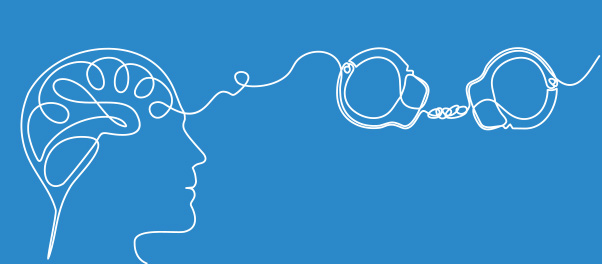Redesigning the Legal System Using Psychology
While there is evidence for the continued success of cognitive behavioral programs, researchers and clinicians have also been aware of third-wave approaches to treatment, such as Acceptance and Commitment Therapy (ACT) and Dialectical Behavior Therapy (DBT). These interventions incorporate distress tolerance and interpersonal effectiveness skills and have consistently demonstrated their effectiveness for difficult-to-treat diagnoses, such as personality and substance use disorders.
The skills taught in DBT address many of the most significant risk factors for crime.
- “interpersonal skills” can help individuals address many of the maladaptive interpersonal styles that lead to developing pro-criminal peers.
- “emotion regulation” can help individuals better manage their emotions to prevent aggressive or impulsive behavior.
The use of DBT can help staff learn alternatives to the use of punitive punishments. Researchers have noted that when staff is provided with appropriate training and interventions are matched to behaviors, the effectiveness of adapted DBT interventions is enhanced.
DBT is an intensive program (which would make it appropriate for high-risk individuals), but it can also be adapted to suit the risk level of individuals.
How Does DBT Treatment Within A Forensic Population Differ From Standard DBT?
DBT clinicians must find creative, straightforward ways to distill complex skills in a way that works for individuals in these settings. Alterations made to DBT programs within forensic settings included changes to the length of the program, the components of DBT used (e.g., skills modules, individual therapy, between-session coaching, consultation groups), and the materials presented during the skills training sessions.
Alterations to Program Length
Manualized DBT recommends that the four skills modules are taught over six months and then repeated. However, previous implementation research discussed different versions of their program (anywhere from 12-48 weeks long). Repetition can facilitate learning DBT skills.
Alterations to DBT Components
All four skills modules of DBT are crucial to employ. However, other parts of DBT (i.e., individual therapy, consultation teams, and between-session coaching) may vary to some extent.
Alterations to Skills Training Materials
Clinicians must find ways in which experiences in the custodial setting parallel the environment individuals will encounter once discharged. Therefore, additional targets may include behaviors that got them arrested or hospitalized and behaviors that may be problematic after release.
For practical reasons, many implementations changed the wording of the skills manuals to have more straightforward language and the content of their skills training sessions based on the environment and to specifically target criminogenic needs.
- Clinicians can incorporate visual representations of skills and add many active learning strategies into groups.
- More straightforward language (e.g., “Difficulties in Controlling Emotions” rather than “Emotional Dysregulation”).
- Less jargon (e.g., “Relationship Skills” instead of “Interpersonal Effectiveness”).
- More gender-neutral language.
- Amend activities for reducing emotionality to suit a custodial environment (as standard DBT suggestions of having sex, arranging flowers, and having a bubble bath are not appropriate).
Addition of a fifth module that focuses on crime-related behaviors. This module can help individuals and clinicians understand what risk factors are related to criminal behavior and how to prevent crime in the future.
- Integrate crime review or crime cycle analysis components where participants specifically discuss the factors contributing to past crimes.
- Use DBT skills to target antisocial cognitions and behaviors specifically.
- Explore “criminal thinking errors” and how different emotions can guide individuals toward (e.g., anger, wanting revenge) or away from (e.g., fear of being caught, fear of injury) criminal behavior.
In addition, adding an extended pre-treatment phase to their DBT programs may be necessary to increase motivation among participants. In standard DBT, motivating clients are typically addressed in individual therapy sessions; however, in some settings, a lack of resources and competing administrative demands make it impractical to provide individual therapy for all patients.
Research Outcomes for Adapted Dialectical Behavior Therapy to Treat Incarcerated Individuals

The lack of consistent adaptations across settings makes it difficult to determine the effects of adapted Dialectical Behavior Therapy (DBT) for incarcerated individuals. The literature varies concerning the length of DBT programs, individual and group sessions, and participants’ psychiatric and behavioral severity. Research in the forensic arena is not nearly the same quality as the community. Challenges include:
- Most forensic institutions (e.g., hospitals, prisons, and in-patient programs) do not want to wait for the long process of a randomized control trial to be completed before implementing potentially effective treatment.
- Lack of resources to train staff.
- Lack of staff adherence to DBT training.
- Lack of a control/comparison group.
The need for statistical significance may be detrimental to developing a standardized DBT forensic and correctional protocol. However, clinically significant outcomes, such as fewer assaults, a decrease in self-harm, and discharging individuals into the community to live meaningful lives, are essential outcomes – even if statistically, they do not reach significance.
Despite these limitations, researchers have utilized methods that provide promising findings for adapting DBT for justice-involved individuals, and the results are compelling and valuable.
Are Current Adaptations Of Dialectical Behavior Therapy Reducing Risk?
Political, financial, and practical challenges inherent to working in forensic and correction settings have led to significant adaptations being made to DBT. However, the potential for iatrogenic effects in these highly vulnerable populations certainly warrants caution and concern. To quell these concerns, institutions have been building an evidence base to support the use of DBT to reduce risk in forensic and correctional populations. Research includes:
- Population: justice-involved female youth
- Adaptation: the four standard DBT modules and an additional module for teaching “self-management skills”
- Outcome: suicidal acts, aggressive behaviors, and class disruptions significantly decreased
- Population: individuals with borderline personality disorder who are in a correctional setting
- Adaptation: adjusting and adding examples to make the skills material relevant and appropriate, making the vocabulary easier to understand, and having workbooks thermal bound – rather than metal
- Outcome: physical aggression and anger management scores significantly decreased; seeking social support, accepting responsibility, planful problem-solving, and escape-avoidance scores increased; participants reported positive group experiences, and correctional staff noted positive behavioral changes in participants
The Correctional Services of Canada
- Population: three forensic settings (i.e., mental health unit, maximum security unit, and the general population)
- Adaptation: lowering the reading level and incorporating treatment aimed at criminogenic needs. Specifically, a “bridging module” was developed, focusing on the difficulties in breaking the cycle of crime and utilizing a behavior chain analysis to help individuals identify and understand what led to their criminal behavior
- Outcome: DBT participants had fewer disciplinary reports, reduced psychiatric symptoms, and increased clinical skills (e.g., coping and self-control)
- Literature review on the effects of DBT on anger and aggressive behavior
- Outcome: adaptations of DBT can be an effective intervention for treating irritation and aggression in samples of people in forensic and correctional settings
- Literature review of extant forensic and correctional DBT programs
- Outcome: While the evidence base for these programs is limited, modifications are generally consistent with best practices of offender rehabilitation according
Despite persistent challenges, DBT in forensic settings can be highly effective. As a result, forensic DBT clinicians have an opportunity to meet the needs of this population that is highly in need of effective interventions.























